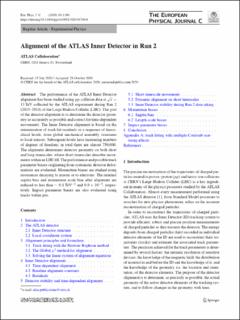Alignment of the ATLAS Inner Detector in Run 2
Aad, Georges; Abbott, Brad; Abbott, Dale C.; Abed Abud, Adam; Abeling, Kira; Abhayasinghe, Deshan Kavishka; Abidi, Syed Haider; AbouZeid, Ossama Sherif Alexander; Abraham, Nadine L.; Abramowicz, Halina; Bjørke, Kristian; Bugge, Magnar Kopangen; Cameron, David Gordon; Catmore, James Richard; Garonne, Vincent; Gramstad, Eirik; Heggelund, Andreas Løkken; Hellesund, Simen; Håland, Even Simonsen; Morisbak, Vanja; Oppen, Henrik; Ould-Saada, Farid; Pedersen, Maiken; Read, Alexander Lincoln; Rye, Eli Bæverfjord; Røhne, Ole Myren; Sandaker, Heidi; Vadla, Knut Oddvar Høie; Buanes, Trygve; Djuvsland, Julia Isabell; Eigen, Gerald; Fomin, Nikolai; Lee, Graham Richard; Lipniacka, Anna; Martin dit Latour, Bertrand; Stugu, Bjarne; Træet, Are Sivertsen; Abreu, Henso; Abulaiti, Yiming; Acharya, Bobby S.; Achkar, Baida; Adam, Lennart; Adam-Bourdarios, Claire; Adamczyk, Leszek; Adamek, Lukas; Adelman, Jareed; Adersberger, Michael; Adigüzel, Aytül; Adorni, Sofia; Adye, Tim; ATLAS, Collaboration
Journal article, Peer reviewed
Published version

Åpne
Permanent lenke
https://hdl.handle.net/11250/2754637Utgivelsesdato
2020-12-24Metadata
Vis full innførselSamlinger
Sammendrag
The performance of the ATLAS Inner Detector alignment has been studied using pp collision data at s√=13TeV collected by the ATLAS experiment during Run 2 (2015–2018) of the Large Hadron Collider (LHC). The goal of the detector alignment is to determine the detector geometry as accurately as possible and correct for time-dependent movements. The Inner Detector alignment is based on the minimization of track-hit residuals in a sequence of hierarchical levels, from global mechanical assembly structures to local sensors. Subsequent levels have increasing numbers of degrees of freedom; in total there are almost 750,000. The alignment determines detector geometry on both short and long timescales, where short timescales describe movements within an LHC fill. The performance and possible track parameter biases originating from systematic detector deformations are evaluated. Momentum biases are studied using resonances decaying to muons or to electrons. The residual sagitta bias and momentum scale bias after alignment are reduced to less than ∼0.1 TeV−1 and 0.9×10−3, respectively. Impact parameter biases are also evaluated using tracks within jets.
